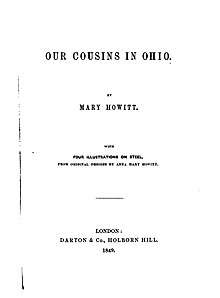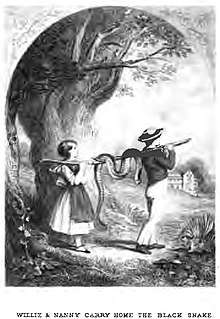Our Cousins in Ohio
Our Cousins in Ohio is an account of a year in the life of a Quaker immigrant family in Ohio in the 1840s, written by Mary Botham Howitt. It is based on letters from her sister Emma Botham Alderson (1806–1847), who left England in 1842 with her husband, Harrison Alderson (1800–1871), and three children, William Charles (1837–1914), Agnes (1839–1925), and Anna Mary (1841–1934).[1][2] In the Preface, Howitt describes Our Cousins in Ohio as a "companion volume" to The Children's Year (1847), which had documented, in a similar way, a year in the life of her own two youngest children, Margaret and Charlton Herbert.[3]
| Author | Mary Botham Howitt |
|---|---|
| Country | United Kingdom |
| Language | English |
| Genre | Family biography |
| Published | 1849 |


History and development
The first edition was dated 1849, though it was available for purchase in December 1848, perhaps to capitalize on the Christmas market. It was reprinted several times in the United States and in England during the 1850s and then again in 1866. The English editions included four engravings based on illustrations by Howitt's daughter, the artist Anna Mary Howitt.[4]
The original letters on which Mary Howitt's work was based are held in Manuscripts and Special Collections at the University of Nottingham in United Kingdom.[5]
Plot and setting
The narrative takes place in and around the family's farm and home, called "The Cedars," located near the village of Athens, a fictional name for the village of Warsaw (now incorporated into Cincinnati) on the west bank of the Great Miami River in Hamilton County, Ohio. The original home was torn down in the 1850s, and the site is now occupied by Seton High School (Cincinnati, Ohio).
Instead of following a single unifying plot, the narrative is organized as a calendar year, with a separate chapter for each month, beginning and ending with classic scenes of emigrant Christmas. Within this calendrical structure are incorporated numerous threads relating to domestic life (e.g. the parents' attempts at dealing with Willy's stubbornness, confrontations with a neighborhood bully, raising crops and livestock, exploring the neighboring woods) and to social issues of the day (e.g. slavery and abolition, soldiers on their way to war with Mexico, westward migration, and the practices of various religious and national groups).
Characters
At her sister's request, Howitt changed the names of many of the characters.[1] The following are some of the names from Our Cousins in Ohio that can be identified with actual people:[2]
| Our Cousins | Model |
|---|---|
| Mother | Emma Alderson |
| Father | Harrison Alderson |
| Willie, William | William Charles Alderson |
| Florence | Agnes Alderson |
| Cornelia, Nelly | Alice Ann Alderson (1844–1855) |
| Felicia Bower | Jane Bonsal (c.1834-?) |
| Madame Leonard | Mary Crehore |
| Cousin Israel Hopper | Thompson Harrison (b. 1813) |
| Cousin Margaret | Elizabeth Mason |
| David Hutchinson | Abraham Taylor |
| Aunt Hutchinson | Elizabeth Taylor |
| Uncle Cornelius | Joseph W. Taylor (1810–1880) |
Literary and historical significance
Our Cousins in Ohio has been identified as an exemplary work of collaborative life writing and domestic literary production. Mary and her husband William, sometimes with the assistance of their daughters, Margaret Howitt and Anna Mary Howitt, collaborated on numerous books and articles. "From the beginning," writes Linda Peterson, "the Howitts' model of authorship was collaborative, including joint publication and, more comprehensively, an approach to authorship as a family activity and business."[6] Later, Peterson notes that in both their content and their mode of production, Howitt's domestic narratives enact an ideology of domestic life and especially of collaborative work that bind the family together."[7]
In extending that domestic collaboration across the Atlantic and focusing on the home of an immigrant settler, instead of on the English home more typical of Howitt's writing, Peterson argues that Our Cousins in Ohio "is based on -- indeed, seeks to extend -- certain British social, cultural, and political values, including the Howitts' Radical abolitionist views."[7]
It has also been noted that Our Cousins in Ohio introduced dozens of American words expressions and words to British readers, often earlier than any recorded instance in the Oxford English Dictionary. Moreover, unlike other writers of her time who wrote about Americanisms, Howitt expresses no disapprobation.[8]
References
- Howitt, Mary (1889). Autobiography. Boston and New York: Houghton, Mifflin and Co. p. 2.48.
- Lee, Amice MacDonnell (1956). In Their Several Generations. Plainfield, NJ: Interstate Print Corp.
- Howitt, Mary (1849). Our Cousins in Ohio. London: Darton and Co. Retrieved 17 January 2020.
- Publication information comes from the title pages of the books and from WorldCat database
- Alderson, Emma. "Letters from Mrs Emma Alderson to members of her family; 1823–1847". University of Nottingham Manuscripts and Special Collections.
- Peterson, Linda (1998). "Mother-Daughter Productions: Mary Howitt and Anna Mary Howitt in Howitt's Journal, Household Words, and Other Mid-Victorian Publications". Victorian Periodicals Review. 31 (1): 31–53.
- Peterson, Linda (2003). "Collaborative Life Writing as Ideology: The Auto/Biographies of Mary Howitt and Her Family". Prose Studies. 26 (1–2): 176–195.
- Anderson, Earl R. (1992). "Americanisms in Mary Botham Howitt's Our Cousins in Ohio (1849)". American Speech: a Quarterly of Linguistic Usage. 67 (3): 326–330.